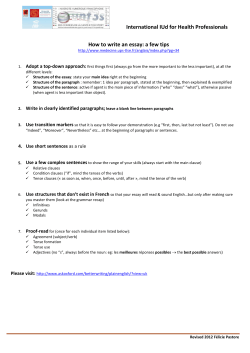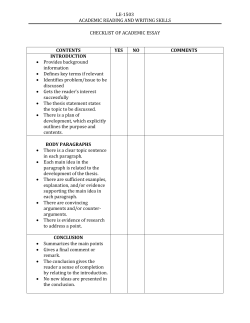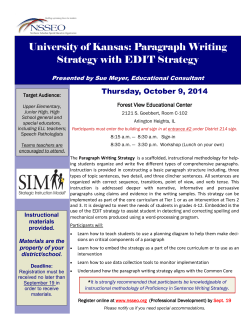
Complex Sentences Year 7 Sentence Starters Icons key:
Complex Sentences Year 7 Sentence Starters Icons key: For more detailed instructions, see the Getting Started presentation Flash activity. These activities are not editable. Extension activities 1 of 22 Web addresses Teacher’s notes included in the Notes Page Accompanying worksheet © Boardworks Ltd 2006 Contents Simple sentences Compound sentences The subordinate clause Relative and adverbial clauses Writing complex sentences 2 of 22 © Boardworks Ltd 2006 Complex sentences: Simple sentences Simple sentences 3 of 22 © Boardworks Ltd 2006 Different types of sentences Hi Max, do you want to revise with me for Friday’s sentence test? Yeah sure Megan. I want to test my knowledge to make sure that I score 100%... Well I want to do well too. I’m going to become a famous novelist, so I need good writing skills. 4 of 22 © Boardworks Ltd 2006 Simple sentences Let’s quickly recap basic sentences… Can you remember the differences between simple and compound sentences? Simple sentences contain a subject, a verb and an object. Simple sentences make sense on their own, e.g. I like tea. Subject Verb Object 5 of 22 © Boardworks Ltd 2006 Subject, verb, object revision Read the sentences below: 1. John loves television. 2. My brother eats worms. 3. Norman picks his nose. verb subject object Decide which words are the verbs, subjects and objects in the sentences. 6 of 22 © Boardworks Ltd 2006 Complex sentences: Compound sentences Compound sentences 7 of 22 © Boardworks Ltd 2006 Compound sentences Now let’s revise compound sentences… Compound sentences are simple sentences which have been joined together by the conjunctions: or, and or but. I like tea. I like coffee. These are two simple sentences. They can be joined to form a compound sentence: I like tea and I like coffee. 8 of 22 © Boardworks Ltd 2006 Simple and compound sentences 9 of 22 © Boardworks Ltd 2006 Complex sentences: The subordinate clause The subordinate clause 10 of 22 © Boardworks Ltd 2006 The subordinate clause Now we need to understand the tricky part – complex sentences... Look at the three sentences below: 1. Mr Farrell, who is our English teacher, always gives great lessons. 2. Liverpool, which is where I live, is an amazing city. 3. I hate my woolly jumper that my granny bought for me. Compare the sentences without the highlighted words… 1. Mr Farrell always gives great lessons. 2. Liverpool is an amazing city. 3. I hate my woolly jumper. 11 of 22 Do the extra words make any difference? © Boardworks Ltd 2006 The purpose of the subordinate clause 1. Mr Farrell, who is our English teacher, always gives great lessons. 2. Liverpool, which is where I live, is an amazing city. 3. I hate my woolly jumper that my granny bought for me. The extra words provide us with additional information about the subject, verb or object… They tell us that… Mr Farrell is an English teacher the speaker lives in Liverpool the jumper was bought by the subject’s granny. 12 of 22 © Boardworks Ltd 2006 Types of clauses The sentence below is a complex sentence. Mr Farrell, Farrell,who who whois is isour our ourEnglish English Englishteacher, teacher, teacher, always always always gives gives gives great great great lessons. lessons. The main and most important idea in the sentence is called the main clause. This makes sense on its own. The additional information is called the subordinate clause. This clause would not make sense on its own. When the subordinate clause splits the main clause down the middle, commas are used to show the boundaries between them. 13 of 22 © Boardworks Ltd 2006 Spotting different clauses 14 of 22 © Boardworks Ltd 2006 Complex sentences: Relative and adverbial clauses Relative and adverbial clauses 15 of 22 © Boardworks Ltd 2006 Complex sentences Okay, so a sentence with a main clause and a subordinate clause is known as a… complex sentence e.g. John walked by the canal that was full of barges. main clause subordinate clause Do you know what sort of word ‘that’ is? 16 of 22 © Boardworks Ltd 2006 The functions of subordinate clauses Subordinate clauses can be used for different purposes: Relative clauses are used to provide more detail about nouns. They are introduced by the relative pronouns who, which and that. e.g. The food that we ate on holiday was delicious. Relative clauses are used in the middle or at the end of sentences. Adverbial clauses describe the verb in more detail. They are introduced by adverbs such as slowly, before, happily, etc. e.g. Before starting work, Roger fed his pet cat. Adverbial clauses can be used anywhere in the sentence. 17 of 22 © Boardworks Ltd 2006 Adverbial and relative clauses 18 of 22 © Boardworks Ltd 2006 Complex sentences: Writing complex sentences Writing complex sentences 19 of 21 22 © Boardworks Ltd 2006 Different types of sentences 20 of 22 © Boardworks Ltd 2006 Writing complex sentences Look at the picture of Megan. Write five complex sentences using subordinate clauses. Use these details: name: Megan owns: a pet tarantula called Mogg species: Mogg is a Chilean Rose wears: hooded tops, patterned tights and boots hair colour: red ambition: to become a writer. Remember: introduce relative clauses with relative pronouns and adverbial clauses with adverbs. 21 of 22 © Boardworks Ltd 2006 Using simple, compound and complex sentences Let’s recap when to use simple, compound and complex sentences… Simple and compound sentences are useful to be brief: in emergency instructions to teach young children for someone who can’t read much English. Complex sentences are useful to be descriptive: to explain something in detail to be precise about what you are describing to keep your reader interested. 22 of 22 © Boardworks Ltd 2006
© Copyright 2025









